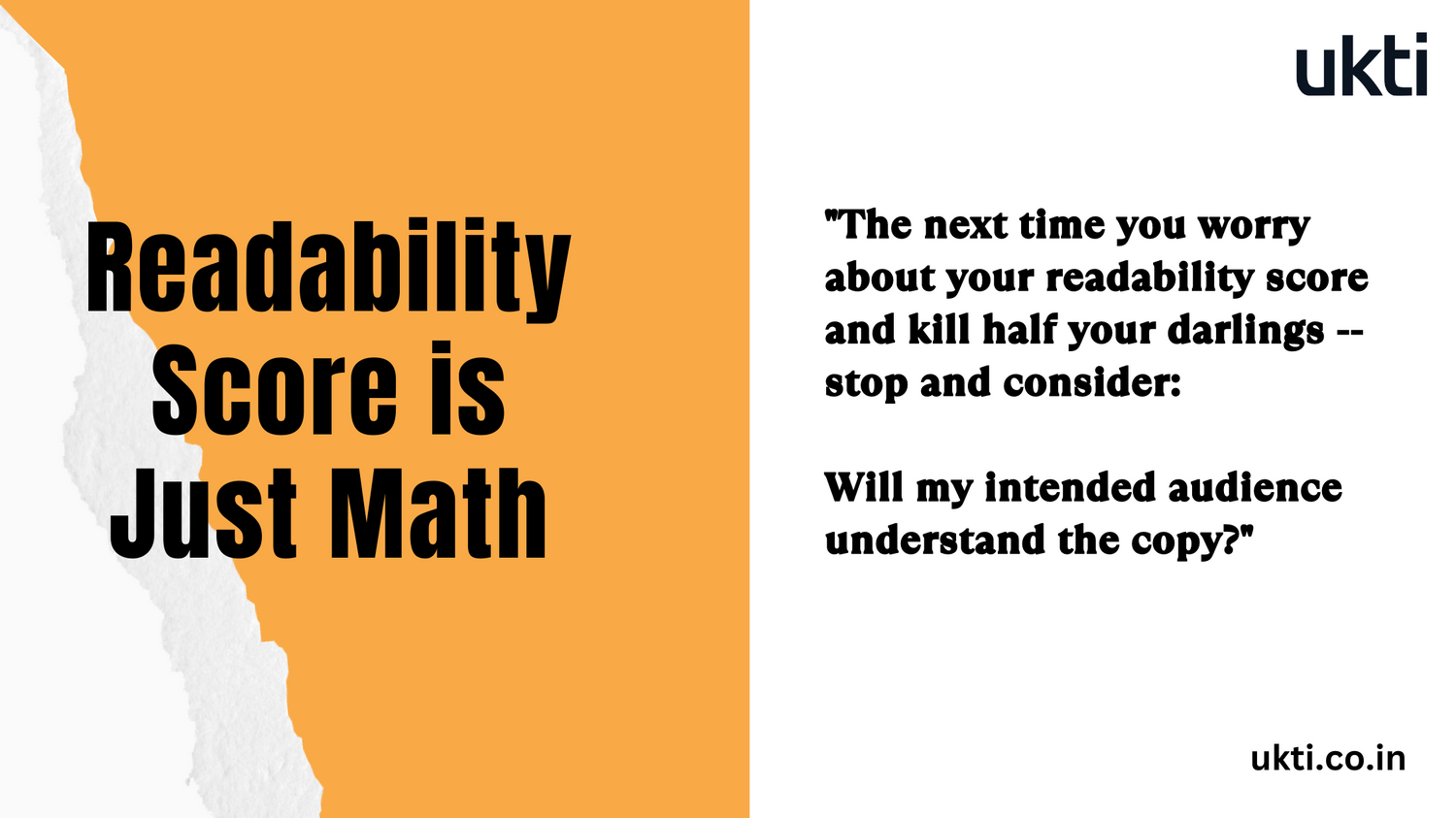A readability score is a number given to a passage of English text based on how much time and education level it takes to understand it.
By definition, it’s clear why the readability score is important. It tells humans (and search engines) how easy it is to read a given piece of content. But if you try and unpack the underlying math behind the score, you’ll be surprised by how irrational it is.
In MS Word, your readability score will appear like this.

I mean…something like this.

Let’s understand the math behind the readability score, how it affects SEO, and how to improve it fast.
How is Readability Score Calculated?
There are many methods to measure readability. But for the sake of argument, we’re relying on the Flesch-Kincaid Readability test (the good-old method MS Word uses).
What is Flesch-Kincaid Readability Test? It is a readability test designed to check the difficulty of understanding a given English text. It assigns a score from 1 to 100, which is inversely proportional to the time someone would take to understand that text.
It considers the average number of syllables, words, and sentences in your text and gives you two types of statistics:
- Reading ease score: This score is given on a 100-point scale. The higher the number, the more readable your copy is.
- Grade Level: This grade reflects the US school grade level required of a reader to understand the given copy.

Now, consider the mathematical formula behind the test:

As you can see, there are two variables in the formula: sentence length and word length. To get a high score on the FRE test, therefore, your average sentence length and word length have to be shorter.
How to Quickly Improve Flesch Reading Ease Score
Now, let us put the above theory to the test and see if it works.
I’m using the text from the above section and running it through WebFX’s free Readability Test tool.

The readability score for the text is 73.5. (It’s already good, but we can do better!)
To lower the average word and sentence length further, I made the following changes to the text:
- Replaced the word ‘measure’ with ‘check.’
- Shortened the “It considers the average number of syllables, words, and sentences of your text and gives you two types of statistics” sentence by putting a full stop before “and.”
- Removed the parenthesis here “(the good-old method MS Word uses.)” and turned this into a new sentence.
Here’s the revised version
There are many methods to check readability. But for the sake of argument, we’re relying on the Flesch-Kincaid Readability test. This is the good-old method MS Word uses.
It considers the average number of syllables, words, and sentences in your text. And gives you two types of statistics:
- Reading ease score: This score is given on a 100-point scale. The higher the number, the more readable your copy is.
- Grade Level: This grade reflects the US school grade level required of a reader to understand the copy.
Let’s check the readability score of the text now.

These simple changes increased the score from 73.5 to 77.8!
Now imagine making such small changes to every section – lowering the average sentence and word length paragraph by paragraph. Wouldn’t your readability score go up naturally?
And all you would need to do is use words with fewer syllables and cut short long-winded sentences. See? It’s just math.
I See…But Why Should I Care About Readability Score?
Let me tell you why.
In 2021, Ahrefs did a mini data study on how Flesch Reading Ease affects SEO.
They studied nearly 15,000 keywords and found no correlation between FRE scores and Google rankings.
In the study, they also stated that,
“FRE is pretty basic with just two variables at play, it wouldn’t really make much sense to use it. So no, readability scores like FRE don’t directly affect rankings.”
If so – what’s all the fuss about?
The thing is, even if the FRE scores don’t affect rankings, they do affect user experience. How readable your content is will dictate how helpful it is to the user. And the “readability” of any content, as far as the Google algorithm goes, is assessed by its readability score.
Here’s how content readability can affect content performance.

If you write in simple language and avoid complex sentence constructions, you are bound to get a good FRE score. However, in all of the above, one vital piece of the puzzle is still missing: the audience you’re writing for.
The Connection Between Readability Score and Audience
Readability scores help you understand if your marketing content is easy to read across educational levels. But what they don’t tell you is whether your content is easy to understand or even useful for your intended audience.
Yes, your audience.
Most readability tests don’t consider the audience’s diversity of knowledge. Instead, their level of comprehension is reduced to a two-digit number.
It’s laughable how everyone has assumed a readability score of “60 or above” to be the standard for good-quality content.
To set the record straight: when trying to check the effectiveness of a piece of content, especially from an SEO standpoint, you shouldn’t go by the readability score alone. Because sometimes – “bamboozled” will do a far better job of conveying shock than “shocked” will ever do.
A given piece of content might get a readability score of 70 or above and still not perform well on SERPs. In the end, it’s the quality and relevance of information that counts more.
That said, if you still care about readability scores, there are definite ways to write highly readable content without dumbing it down.
More Ways to Improve Readability Score Without Dumbing Down
Here are some simple tricks and tips to increase your readability score.
➡️ Use the language of your audience. If you’re writing for healthcare practitioners, you can use “left cerebral hemisphere” instead of “left brain” because they will get it.
➡️ Maintain clarity and flow. Nothing is worse than having to read over, below, and between the lines to find the meaning. Be clear, be precise.
➡️ Litter the content with examples to make it more actionable. To show is always better than to tell. See how it’s done: Does Content Repurposing Work for B2B SaaS?
➡️ Never leave the strings attached. Strings of nouns or prepositional phrases. They kill clarity.
➡️ Write shorter sentences and use active voice. It’s how you create “snackable”, better content.
➡️ Vary your sentence length after every third sentence. That’s how you bring rhythm to your writing.
➡️ And lastly, think of the audience. Always. It will keep your focus on what matters the most.
So, the next time you worry about your readability score and kill half your darlings — stop and consider: Will my intended audience understand the content?
The rest will come easy.
About the Author

